Summer 2014
Frederick James Friend
Fred Friend was born on 7 April 1941. He died after an illness on 23 April 2014. He went to school at Dover Grammar School for Boys, studied history at King's College London and took his B.A. in 1963. He qualified in library and information studies at UCL (University College London) in 1965.
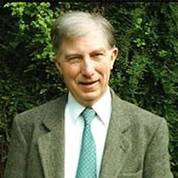
Fred held a number of professional honours during his long career. He was Secretary of SCONUL (2000-04), and Treasurer of the Consortium of University Research Libraries (1996-98). Between 2003 and 2011 he acted as Scholarly Communications Consultant to JISC and was an independent expert for the European Commission from 2006.
Fred was also an Anglican cleric, being made deacon in 1982 and priest in 1983. Latterly, he officiated at Hughenden in the diocese of Oxford.
Professionally, Fred was fully committed to development and innovation in academic libraries. As Librarian at UCL, Fred was responsible for developing its digital library offering. He was passionate about the importance of digital delivery and today, thanks to the foundations that he laid, UCL has one of the best digital library presences of any university in the UK, highly commended in the Student Barometer and International Student Barometer.
The issue with which Fred came to be closely associated was that of Open Access to research publications. Open Access has been defined as 'unrestricted online access to peer-reviewed scholarly research'. Since research outputs are free at point of use, inability to pay is no longer a barrier to access. Fred sealed his reputation in this area by becoming one of the authors of the original Budapest Open Access Initiative, one of the key documents in the development of the Open Access movement. Fred lectured and published widely on Open Access via his website. He passionately believed that Open Access represented a fundamental change in the way in which knowledge is communicated and so can be shared. At the base of his beliefs was a commitment to the democratisation of knowledge and a willingness to fight for those beliefs in a very public way. It was an approach which he brought from his theological studies into the world of research and librarianship.
When I joined UCL as Fred's Deputy Librarian in 1997, we immediately recognised that we shared a common interest in ecclesiastical history and this formed the subject of many conversations over coffee. I remember having a particularly detailed discussion with him about episcopal Registers of the medieval and early modern church - a discussion so detailed that the only people I had talked to about this subject on similar terms were my PhD examiners. Fred was unfailingly kind. Many colleagues in the library profession, in the book of Tributes which has been collected by Dr Alma Swan, remember Fred's personal kindness and willingness to support younger colleagues, particularly in their growing awareness of Open Access issues.
What I remember most about Fred was the tenacity with which he held opinions on Open Access, views which he defended resolutely in front of commercial publishers. Often, he was the first person in the room to voice his opinions, knowing full well that they would attract criticism in some quarters, but wisely understanding too that in order to make an omelette, one has to crack a few eggs.
Fred is survived by his wife Margaret, whom he married in 1969, a son Edward and a daughter Cate. In Who's Who, Fred listed his recreations as walking the dog and prayer. This is entirely characteristic of someone who could be a very private individual, committed to his own ideas and priorities, but who was full of compassion for those with whom he came into contact.
by Paul Ayris, Director of UCL Library Services
Seeing Inside the Inner Eye
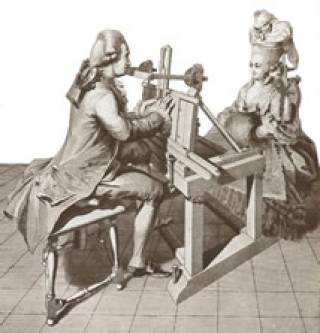
Eye tests before Helmholtz: an 18th century engraving by Jean Baptiste Pierre Tardieu
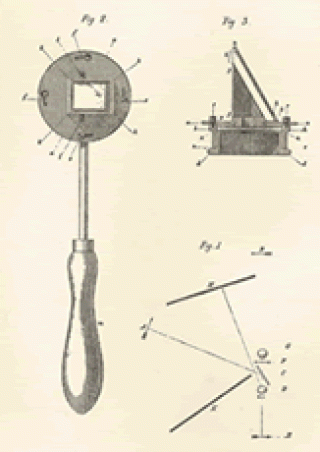
The ophthalmoscope from the first edition of the Beschreibung by Helmholtz.
Helmholtz reported his 'discovery' in a short, 43 page work with the title Beschreibung eines Augen-Spiegels zur Untersuchung der Netzhaut im lebenden Auge (Description of an eye-level to study the retina in the living eye) published by A. Förstner'sche Verlagsbuchhandlung before the end of the year, by which time 18 customers had placed orders for the new device. These were constructed by Egbert Rekoss, a university technician, but it soon became apparent that refractive errors interfered with the image the ophthalmoscope delivered. Rekoss himself solved the problem in 1852 by adding a series of lenses mounted on two rotatable discs, one convex and the other concave. The discs are named after him even today.
Many ophthalmologists were against the use of this new device because of the (as they saw it) perceived dangers of shining a light directly into the eye but it soon became apparent that they were wrong. Helmholtz himself was a polymath with an enormous range of interests including the other senses, acoustics, the conservation of energy, electromagnetism and fluid mechanics. One of his most famous achievements was providing proof that the nervous system works by electric impulses through his experiments on a dead frog. Helmholtz himself never believed that his ophthalmoscope marked the beginning of a new era for the study of ophthalmology though many improvements to his original device had been made by others by 1867 when he finally completed his enormous three volume Handbuch der physiologischen optic of which the Ophthalmology Historical Collection has the second and third German editions.
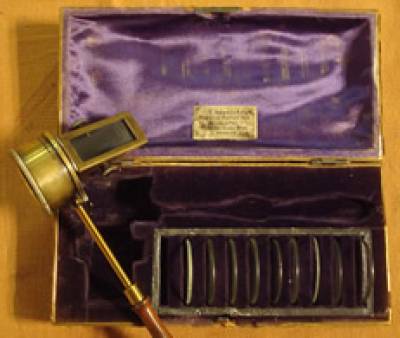
One of the first ophthalmoscopes Rekoss constructed. Now in the Institute of Ophthalmology Collection.
The first translation of the Beschreibung into English was made by Thomas Hall Shastid and published by The Cleveland Press in Cincinnati in 1916, that is sixty-five years after the original work was published. It has 33 pages and contains a reproduction of the original illustration in Helmholtz's work. The Institute of Ophthalmology copy has a label "With the Translator's Compliments" which is probably intended for Sir John Herbert Parsons who later presented it to the Institute, one of well over a hundred works that Parsons contributed to the Ophthalmology Historical Collection.
The collection also has a first edition of Beschreibung eines Augen-Spiegels zur Untersuchung der Netzhaut im lebenden Auge and one of the first four ophthalmoscopes made by Egbert Rekoss can be seen on display in the Institute of Ophthalmology library among many other artefacts that trace the development of the discipline.
by Bill Lehm, Retrospective Cataloguer
The Institute of Archaeology Library, the Monuments Men and the Censor
Amongst the many treasures and archives held by UCL Special Collections is the Institute of Archaeology Library Archive. At first sight this modest archive, consisting of three box files of materials dating from 1939-1964 (box files 1 and 2) and between 1975 and 1988/89 (box file 3: restricted access), appears to be of limited general interest. But on closer examination, it is revealed to be a rich source for the post-war history of archaeology and for the general recovery of Europe after World War II. Scholars within the archaeology community, long isolated from one another by war, began to pick up the threads of their personal and professional relationships and help each other repair their museums and institutions, with the restocking of libraries as a priority. When the usual channels of communication failed, the Institute Library used ingenious alternatives, calling in the help of the Monuments Men and using personal contacts in the Ministry of Education, including the future Secretary of the British Board of Film Censors, John Trevelyan, best known for his controversial liberalising approach.
Two sets of correspondence record the attempts made by the Institute of Archaeology to send books to two internationally-respected archaeological institutions in Germany - the DeutschesArchaeologischesInstitut (DAI) in Berlin (Winker/Childe: 17/02/1947) and its associated organisation, the Romisch-GermanischeKommission (RGK) in Frankfurt (Wagner/Childe 20/06/1948). The uncertainty and privations that German archaeologists suffered during the difficult years of the Allied Occupation (1945-1949) are highlighted. Particularly fascinating is the role played by Gordon Childe, the Director of the Institute, for Childe - an ardent Marxist - had been an open opponent of the Nazi regime from its earliest days, unafraid to condemn them in print.
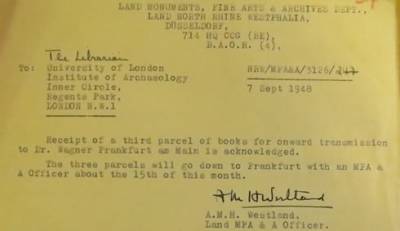
The delivery of books to the DAI in the divided city of Berlin, which was rapidly developing into a 'flash-point' of contention between the Allies, was facilitated by officials in the Ministry of Education: A.R. (Aylmer Robert / Bill) Maxwell-Hyslop and John Trevelyan (Maxwell-Hyslop/Trevelyan: 27/01/1947; Trevelyan/Maxwell-Hyslop: 27/01/1947). This was an ingenious and simple route, for A. R. Maxwell-Hyslop was married to Rachel Maxwell-Hyslop, assistant lecturer in Western Asiatic Archaeology at the Institute! Trevelyan was in Germany to set up the 'British Families Education Service', which provided education for the children of Allied Servicemen based there and had a range of resources at his disposal, including much-needed transport. This assistance, although probably unofficial and personal, was in line with formal British attitudes to denazification; assistance in rebuilding schools and universities and fostering close links between Britain and Germany was seen as vital for the recovery of the country. Trevelyan was to leave education services in 1951 to work for the British Board of Film Censors, becoming Secretary from 1958-1971. During his tenure, Trevelyan was to display the pragmatism and liberal approach seen here, most famously passing the Ken Russell film 'Women in Love' in 1969, which featured a controversial male nude wrestling scene. His memoirs 'What the Censor Saw' (1973) tell the story of his work.
Reaching the RGK at Frankfurt, located in the American Zone, was similarly achieved using informal routes into official organisations, this time the Land Monuments, Fine Arts and Archives Department (MFAA). Better known as 'the Monuments Men', the work of this small, but dedicated organisation was recently made famous by the film 'The Monuments Men' starring George Clooney and Matt Damon, based on the book by Robert Edsel. Surviving letters (Westland/Du Plat Taylor: 19/08/1948; Westland/Du Plat Taylor: 07/09/1948) describe how A.H.M. (Althea) Westland, one of the few British female officers with the organisation, arranged for books to be sent by car over the border between the British and American zones from Dusseldorf to Frankfurt. The letters are formal, suggesting no personal relationship existed between Althea and the Institute. Instead, personal intervention probably took place at a higher level, most likely by Sir Leonard Woolley, who was Archaeological Advisor to the Director of Civil Affairs in the office of SHAEF, the Supreme Headquarters Allied Expeditionary Force and Head of the Monuments Men. Woolley, a famous Near Eastern Archaeologist, knew many staff at the Institute, including the Librarian, Joan Du Plat Taylor. Alternatively, the connection may have come through the Institute's founder, Sir Mortimer Wheeler, whose life-long dedication to the protection of endangered monuments began when he saw the damage done to the ancient Roman cities of North Africa while fighting with the British Army there. Transporting books was hardly part of the MFAA's remit, which was set up to mitigate combat damage to monuments and locate stolen or missing art and cultural objects, so the organisation's co-operation attests to the strength of the Institute's connections and its persuasive powers.
Both institutions - the RGK and the DAI - did receive their books from the Institute of Archaeology. The efforts of all those involved - the Institute, Gordon Childe, the Monuments Men, Bill Maxwell-Hyslop and John Trevelyan is testament to the creativity that many people displayed in the face of difficulties and shortages caused by war and the willingness of all involved - both in Britain and Germany - to put the conflict behind them and begin again.
by Katie Meheux, Deputy Librarian, Institute of Archaeology
Profile: Lara Speicher
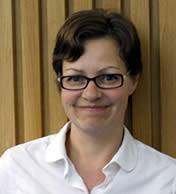
I am Publishing Manager of the newly re-established UCL Press. The UCL Press imprint was previously licensed to Taylor and Francis but they had not used it for some years and the imprint was repatriated to UCL in August 2013. Senior Management Team felt that it was important to have a Press here at UCL and it is great to be part of the team setting that up. I have always worked in publishing and prior to this I was Commissioning Editor at British Library Publishing where I commissioned a range of new books based on the Library's collections, including previously unpublished novels and letters by authors such as Arthur Conan Doyle, Ted Hughes and Keith Waterhouse, illustrated non-fiction on subjects such as cartography, history and botanical illustration, reprints of crime novels from the 1860s to the 1930s, and exhibition books.
My role is to work with Library colleagues and the Board to establish the infrastructure, strategy and governance of the Press. We are starting completely from scratch so everything involved in running a publishing business needs to be put in place. Finding new authors to publish with the Press is the obvious starting point but in addition I need to get all other aspects of the Press up and running, including recruiting new staff, commissioning a website, establishing our peer review policy, writing business plans, sourcing suppliers, writing author guides, setting up boilerplate contracts and, not least, getting to know UCL! We will be an Open Access publisher from the outset which is a bold move and demonstrates UCL's commitment to making its research outputs available to as wide an audience as possible. We will mainly be publishing academic monographs, textbooks, conference proceedings and journals. We've had lots of great proposals so far and look forward to receiving many more. If you have any questions please don't hesitate to contact me.
by Lara Speicher, Publishing Manager, UCL Press
The Ladies' Samaritan Society: 1861-2014
Queen Square Library, Archive & Museum celebrated #MuseumWeek with a new exhibition: "The Ladies' Samaritan Society: 1861-2014".
The exhibition, which will be on display in Queen Square Library, 1st Floor, 23 Queen Square, until end of July 2014, features photographs of founding and current members of the Society, fundraising publicity materials and objects, and has been curated by Ladies' Samaritan Society volunteers, who have provided invaluable support to Queen Square Archives over many years.
For more information, go to:
by Sarah Lawson, Librarian, Institute of Neurology, Queen Square Library
Special Collections Out & About
Our Special Collections Team have been very busy lately so here are some photos from their recent "Treasures Day" for the UCL Festival of the Arts, and Dante Day in collaboration with the Warburg Institute.
The day showcased the outstanding collection of early and rare Dante editions held in UCL Special Collections, and included readings and talks by Professor John Took (UCL Italian Department), Dr. Alessandro Scafi (The Warburg Institute) and Dr. Tabitha Tuckett (UCL Rare-Books Librarian).
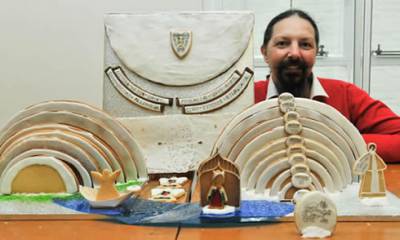
Above: Leon Conrad, one of the participants at Special Collections' Dante Day on 17 May, with a small part of his recreation of Dante's Divine Comedy in biscuit form. Photo reproduced courtesy of David Ward.
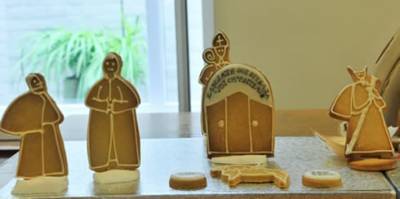
Above: Dante and Virgil contemplate a couple of edible sins, a bishop and a devil. Photo reproduced courtesy of David Ward.
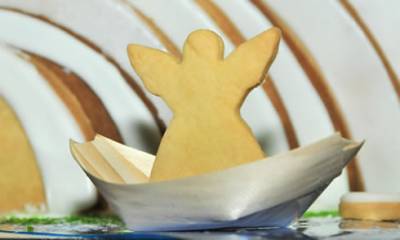
Above: Getting around Inferno, Purgatory and Paradise as a biscuit angel: part of Leon Conrad's creation for Special Collections' Dante Day. Photo reproduced courtesy of David Ward.
by Tabitha Tuckett, Rare-Books Librarian
Moves Afoot
As part of the redevelopment of Wates House the Bartlett Library will be moving into a new permanent home in Central House over the Summer. The Library will close in Wates House on Friday 25th July and open in Central House on Monday 4th August.
For more information, go to:
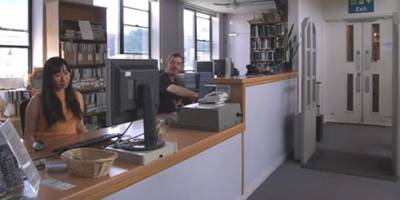
by Caroline Fletcher, Librarian, Bartlett Library
 Close
Close

